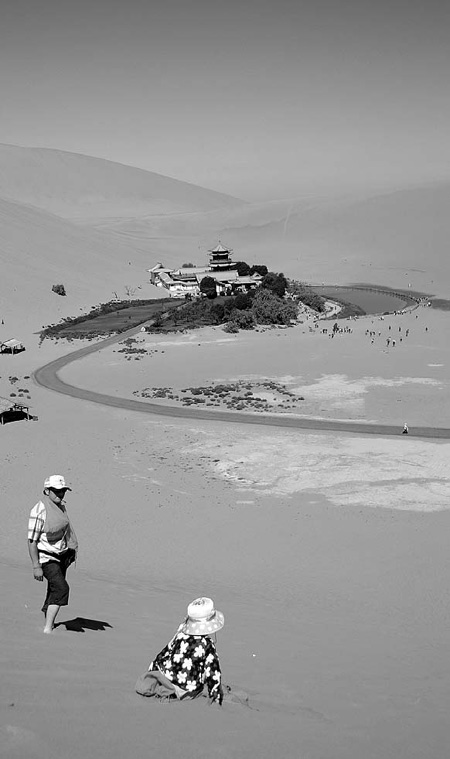
Tefnut's Environmental and Drought News Article

Updated: 2011-08-08 07:53
By Jin Zhu (China Daily)

A man and his daughter enjoy themselves at the Crescent Moon Lake resort in Dunhuang, Gansu province. Sand has filled in large parts of the lake. Gao Jianjun / Xinhua
BEIJING - China has pledged to conserve water resources in the renowned oasis city of Dunhuang to prevent it from being destroyed by desertification, a top official has said.
Dunhuang of Gansu province in Northwest China, located on the ancient Silk Road, was known for the Mogao Grottoes, China's first World Heritage site, as well as its beautiful scenery.
But over-exploitation of water resources has already caused environmental deterioration, Minister of Water Resources Chen Lei told a conference on water utilization and ecological protection in Dunhuang on Saturday.
The environmental damage includes massive shrinkage of natural wetlands and forests, as well as desertification.
For instance, the water level in the Crescent Moon Lake, a crescent-shaped lake and famous scenic spot, has dropped to 1 meter compared with 8 meters in the 1960s, according to ministry data.
The forests of Dunhuang have shrunk by 40 percent, meadows by 62 percent and wetlands by 68 percent over the past six decades, official statistics show. The oases now only cover 4.5 percent of the city's area of more than 30,000 square kilometers, which is five times as large as Shanghai, according to local official figures.
"Increasing population and massive land reclamation have consumed too much water in previous decades," Chen said. "Water has become a bottleneck to the sustainable development of the city."
Desertification is also threatening the 1,000-year-old Buddhist frescoes in the Mogao Grottoes, he warned.
To save the historic city from drying up, the State Council, or China's cabinet, approved a 10-year plan in June for preserving the oasis. Implementation of the plan started in July.
The plan, costing more than 4.7 billion yuan ($730 million), includes building channels to bring water in from outside sources, promoting water conservation technologies and methods, rationing water use and planting more trees and wetland plants.
Ma Jun, director of the Institute of Public and Environmental Affairs, a non-government organization based in Beijing, said on Sunday that setting up a water conservation system was urgently needed to prevent the city from disappearing into the desert.
"As the local economy currently relies on the water-consuming agriculture sector, the plan highlights water-saving irrigation," Ma said.
"But water pollution, triggered by growing industrial development, should also be taken into consideration in the future, since pollution is another way to waste clean water," he said.
Source: China Daily
© 2010-2026 Bill McNulty All Rights Reserved